Jen Hachigian: Lore unto Herself.
Posted: Wednesday, August 29, 2001
By: Darren Schroeder

When I reviewed the anthology Periphery I was especially taken by a short piece called Lore: Imperfect Gentleman which was done by Jen Hachigian. It is an interesting taste of her ongoing series and made me curious to see more. Being a naturally nosy person I tracked Jen down and pestered her with a barrage of questions...
Darren Schroeder: What is your full name?
Jennifer Lynn Hachigian
DS: Age?
JLH: At the time of this writing, I'm almost 26.
DS: Favourite web site?
JLH: I probably should use this opportunity to plug the worthy http://www.cbldf.org, the informative http://www.deja.com or the wonderful http://www.flay.com right now...but I confess that I visit http://www.AnimeonDVD.com and telnet to bbs.isca.uiowa.edu (which has a cool "Comics and Animation" forum) every time I surf the Web.
DS: What picture (Photo, painting, drawing etc) if any has had the greatest impact on you?
JLH: That's a tough question. Everyone and everything influences my artwork, but I can't say if one picture had more of an impact than another.
DS: What was the first comic you published yourself and how did that come about?
JLH: I printed Lore #1 and #2 simultaneously in 1995.
In the beginning, I had some characters who I had drawn for years, and I wanted to tell a story about them. I read Dave Sim's articles on self-publishing (they ran in Cerebus #168-189) and later started drawing pages in 1994. I had no idea how I would publish it at the time, or if I would publish any of it at all.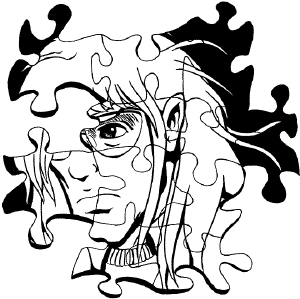 Part of the solution came in 1995, when a fellow student in an art class showed me some of his small press comics. I didn't know they were called small press comics at the time, but that was when I learned that one could use a photocopier to print comics. The other part of the solution came when I bought a "long-reach" stapler at OfficeMax.
Part of the solution came in 1995, when a fellow student in an art class showed me some of his small press comics. I didn't know they were called small press comics at the time, but that was when I learned that one could use a photocopier to print comics. The other part of the solution came when I bought a "long-reach" stapler at OfficeMax.
I had thought only friends and family would buy Lore, but I made the happy mistake of overprinting. I sold the extra comics through local comic shops. To my shock, I got an enthusiastic fan letter. It encouraged me to keep selling through local comic stores, and it gave me the nerve to try selling Lore at comics conventions and through mail order.
DS: There wasn't any "Comics are for kids" sentiment in the art class?
JLH: None that I remember. Heck, pages 1-31 of Lore #3 formed my semester project for my Drawing II class.
I've heard of art teachers that refuse to even look at the comics medium, so I've been lucky.
DS: Would you go out with someone just because they had access to a photocopier?
JLH: No.
DS: Who do you see as the target audience for your work?
JLH: For Lore, I'm not sure. My original target audience was friends from high school, but current readers range from old to young, male and female. I'd like to reach everyone with Pocket Editor, though.
DS: What work have you been doing recently?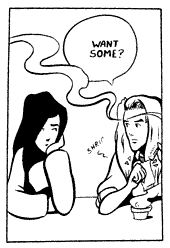 JLH: I'm working on Lore #11, but my most recent work has been Pocket Editor #2. Outside of comics, I run the Celshader.com website, and I wrote two pieces for the upcoming LightWave 6.5 Applied tutorial book.
JLH: I'm working on Lore #11, but my most recent work has been Pocket Editor #2. Outside of comics, I run the Celshader.com website, and I wrote two pieces for the upcoming LightWave 6.5 Applied tutorial book.
DS: What comics have you read recently? Why did you like/dislike them?
JLH: Trade paperbacks form the bulk of the comics I read now. As for titles that I've read recently...
Hitosi Iwaaki's Parasyte keeps me wanting to know what happens next. The occasional gore may turn off some readers, though. It has got to be one of the most addictive reads for me right now. Carla Speed McNeil's Finder: Sin Eater has a stunningly detailed view of a distant future. Pam Bliss' Dog & Pony Show features whimsy, insight, and adorable depictions of dogs. Scott Roberts' artwork in Patty Cake: Prime Collection distorts characters, props and camera angles to amazing effect (it's also funny as hell). Nik Dirga and Max Ink's Amoeba Adventures: Mushrooms and Dinosaurs is both charming and a lot of fun. Each work also has compelling characters and a sense of humor. I liked 'em all.
Other graphic novels I like include: Mark Crilley's Akiko, Peter David's Soulsearchers & Company, Colleen Doran's A Distant Soil, Matt Feazell's ERT!, Neil Gaiman's Sandman, Moto Hagio's A, A Prime,Alan Moore's From Hell, Wendy Pini's Elfquest: Fire & Flight, Jeff Smith's Boneand Osamu Tezuka's Black Jack
...and anything by Will Eisner.
I think most of these titles can also be purchased through Alldirect.com or Amazon.com, if the local comics shop doesn't carry them.
DS: What does the term small press mean to you?
JLH: From what I've seen, it means an even greater variety of comics out there for me to read.
DS: Can you describe Lore for us?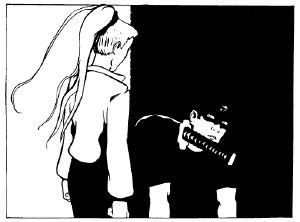 JLH: Lore follows the story of a shy telekinetic named Dragona Lore Smith and the people who drift in and out of his life. It takes place in the future, so you get to meet robots, cyborgs, cat people and holograms. Lore's world has traces of the supernatural as well, in the form of witches, vampires and the occasional half-vampire.
JLH: Lore follows the story of a shy telekinetic named Dragona Lore Smith and the people who drift in and out of his life. It takes place in the future, so you get to meet robots, cyborgs, cat people and holograms. Lore's world has traces of the supernatural as well, in the form of witches, vampires and the occasional half-vampire.
Lore also attends Catholic high school, so I pitch Lore to potential readers as Robots, Vampires, and Catholic High School.
DS: What was the appeal of a high school setting?
JLH: Some of my most vivid memories took place in high school. When I started the comic, it was also the environment I felt most confident about drawing, since I had just gone through four years of it.
DS: I read Lore: Imperfect Gentleman in issue one of Periphery. How did you get involved with this anthology?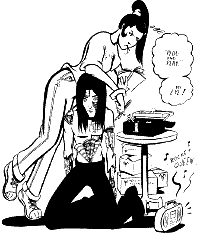 JLH: A fellow comics creator suggested that I send material to arch*type for the upcoming Periphery anthology. Anything I sent, I would still own, which meant a lot to me. So I sent Imperfect Gentleman, a four-page story about the robot Axl Grey, who first appeared in Lore #1 as the janitor of Lore's high school.
JLH: A fellow comics creator suggested that I send material to arch*type for the upcoming Periphery anthology. Anything I sent, I would still own, which meant a lot to me. So I sent Imperfect Gentleman, a four-page story about the robot Axl Grey, who first appeared in Lore #1 as the janitor of Lore's high school.
DS: How much of the storyline of Lore do you have mapped out in advance, or do you write it issue by issue?
JLH: I have a general idea of where I want to go with the characters, but I'm never quite sure what's going to happen in a comic until the comic's almost finished.
DS: How have your skills as a comic creator changed over the course of Lore?
JLH: I think my drawing skills have improved since Lore #1. My inking has gotten cleaner and my lettering more legible. I learned how to use lettering guides, technical pens, lettering nibs, French curves, Micron pens and brushes.
I'm more aware of what happens in a story and in a comics page. I now try to tell the story as visually as possible, whenever possible.
I'm still learning, though.
DS: Your site goes into great depth about 3d modeling/animation. Is this a hobby or a job for you?
JLH: I've worked on various projects as a 3D professional since 1999.
DS: Ever thought of using 3D model process to produce a comic?
JLH: I did experiment with computer backgrounds in Lore #9 and #10. The locker-filled hallway, chair-filled cafeteria, cityscapes and janitor's closet were celshaded LightWave 3D models, and I created the grayscales and abstract backgrounds with Photoshop.
A fully computer-rendered Lore comic would take longer for me to create. It's faster for me to draw the characters by hand.
DS: The angelic girl on your webpage is a striking image, how long did it take to create that?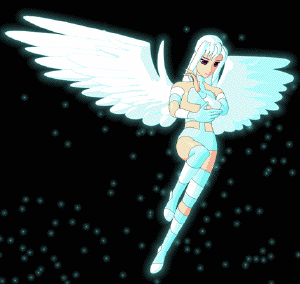 JLH: I created her a few years ago...I think it took me a few days to build the model, a day to set up the character and another day to create the image.
JLH: I created her a few years ago...I think it took me a few days to build the model, a day to set up the character and another day to create the image.
DS: What made you decide on a career in the visual arts?
JLH: I've enjoyed watching graphic storytelling in animation, art, comics and video games ever since I was a kid. Back in 1993, I wanted to help create video games.
Video game magazines back then suggested that artists who wanted to break into the video game industry would have a better chance with a computer science degree. So, I signed up for computer science classes at Michigan State and buried myself in studies. Before I got my degree in 1997, I learned two things:
1) Video game artists no longer needed computer science degrees (if they ever did).
2) Video game companies (and film and TV studios) wanted folks who could use 3D software.
I learned LightWave and eventually got hired. I've been doing 3D work ever since.
DS: I've read that many female computer science students find the discipline to be dominated by geeky males who lack social skills to such an extent that it makes studying quite an isolating experience. Did you find this to be the situation in your case?
JLH: I only remember cool and handsome male classmates in the Michigan State classes. Some of them read comics, most of them preferred Linux or OS/2 for their home operating systems, and all of them studied hard, but I had no problem with any of them when we got together for study groups.
If anything, I suspect I was the geekiest student in class.
DS:Is there much work available in that line? What sort of things have you done?
JLH: Computer animators generally work on a project-to-project basis here in Los Angeles. When a project ends, the studio will try to roll the animators on to other projects. If the studio has no projects left, it lets everyone go. Sometimes studios have lots of work, sometimes they have no work. No job security exists out here.
So far I've worked on a celshaded ride film and a computer-animated British TV series. I've also built models for clients as a freelance artist. It can be a lot of fun, but because of the lack of job security, it's not for everyone.
DS: Is drawing the basis of all the visual arts?
JLH: I should kid around here and say, "Ask a sculptor." I'm sure at least one or two sculptors rough their designs out on paper first, though.
Solid pre production (storyboards, blueprints, designs, etc.) can spare artists a lot of headaches. On the other hand, I know 3D artists who (say they) can't draw, but who can create anything they imagine in 3D. A good eye is a good eye.
I still think the ability to draw well is a good tool to have, if only for the sake of preplanning.
DS: How do you store the pictures you create on computer, files or printouts? Is one form better than the other and if so why?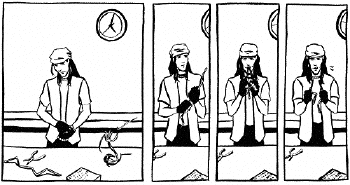 JLH: Since Lore #9, the finished work is stored in grayscale file format. I still need to make printouts for the copy machine, though.
JLH: Since Lore #9, the finished work is stored in grayscale file format. I still need to make printouts for the copy machine, though.
Either method risks loss. Printouts tear and yellow if I don't take care of them; files can be lost forever if I don't back them up. Keeping the files in grayscale format lets me pick the resolution of my screentones for the final printout, though, so right now I prefer files.
DS: What sort of computer do you use currently?
JLH: I use a dual 533Mhz Celeron (Abit BP6 motherboard), 512MB of RAM, an antique TNT2-based video card, Plustek A3i OpticPro scanner and true-1200dpi laser printer. I use Windows NT 4.0 for my operating system. (I used to overclock the Celerons to higher speeds, but my system was getting a little too hot). For what I do, it's good enough
DS: What sort do you wish you had?
JLH: A dual Athlon with at least 512MB of RAM, a GeForce3-based video card and a new 11x17 scanner (my Plustek sometimes goes on the fritz). I also wish I could run all my hardware and software on an operating system like Linux, OS/2 or BeOS.
DS: Where do you stand on the issue of musical numbers in animated films? I hate it when all those Disney animals break out into song during a movie.
JLH: No rule says a film must be a musical. Musical films include The Sound of Music, The Music Man and most Disney animated feature films. Non-musical films include Casablanca, Seven Samurai and animated features such as Toy Story, Toy Story 2, Shrek and The Iron Giant (one of the best films of the past ten years).
Animated films do not have to be musicals. I'm glad Disney tried something different with Atlantis, and I hope they continue experimenting with other genres.
Meanwhile, folks looking for a specific genre in animation can find it in imports like Perfect Blue, Kiki's Delivery Service and Ninja Scroll. I suspect that the variety of genres, stories and characters in Japanese animation form part of the reason for its growing popularity here.
DS: I haven't seen Disney's Atlantis, what was different about it?
JLH:Atlantis had no songs, no talking animals and targeted an older audience with its story and characters. I didn't think it was as good as Iron Giant (my current yardstick for animated feature films), but I thought it worked better than Titan A.E. (another adventure-based animated feature with one or two similar elements).
I hope Disney continues to explore other genres with their animated features.
DS: Akira was the film that seemed to spearhead the success of Japanese animation in the western market. What do you think about that film?

JLH: I finally got to see the entire film in a theater last month. Akira knocked my socks off. My jaw dropped open more than a few times while watching it. The beautiful visuals and the level of detail astounded me. I'll pick up the DVD for certain when it comes out.
DS: Where did you study, and what do you think of the course now.
JLH: I graduated from Ladywood High School in 1993. In 1997 I received my bachelor's degree in computer science from Michigan State University, with a minor in Studio Art.
I had a fantastic art teacher in high school, who gave me a good start in understanding composition. The MSU art classes further improved my draftsmanship skills, and I'm currently taking night classes at the American Animation Institute for understanding anatomy, life drawing and perspective.
Art teachers, at their best, increase the student's ability to express ideas visually. The best art classes have taken some of the guesswork out of my drawing.
DS: Do you still follow Cerebus?
JLH: I don't follow the monthly comic, but I plan to pick up the trade paperbacks sometime in the future.
DS: Where's local for you?
JLH: "Local" used to be Michigan, but I live in Burbank, California now.
DS: Are the shops there supportive of small press?
JLH: I have not yet approached comic shops in the Los Angeles area, so I can't say. Most of the comic stores near me in Michigan carried Lore, though.
DS: For those of us living outside it, Los Angeles has a dreamlike quality. What's it like to live in that dream?
JLH: Los Angeles has a dreamlike quality for me sometimes, too. Sometimes it can be so beautiful. If you looks down from a high viewpoint at night, the city spreads out like an ocean of lights. The smog diffuses the light, and a glowing haze blankets the city. It reminds me of Blade Runner.
Sometimes, it's not so beautiful. In the daytime, if you drives into town from a not-so-polluted area like Valencia, you'll get a good view of the smog layered over the city, a sickly brownish-yellow. Inside the city, a you can sometimes gauge the level of smog by how well you can see the mountains bordering the city.
Los Angeles can be fun -- I like Little Tokyo, sushi, the Anime Expo, the ocean, the American Animation Institute classes. On the other hand, Los Angeles can also be frustrating -- I don't like the smog, the lack of parking, the weird roads, the high price of renting an apartment or the intensity of highway traffic. It balances out.
DS: So, was Deckard a replicant?
JLH: Deckard was human in Philip K. Dick's novel, but the movie leaves it up to the viewer. Ridley Scott (the director) announced a while ago that Deckard was a replicant, but I read somewhere that Harrison Ford (who played the role of the character) believes that Deckard was human.
The unicorn dream (and the unicorn origami figure) of the director's cut might prove that Deckard is a replicant, but since the movie never spells it out, the viewer is still left free to make his or her own choice.
I think Deckard might have been a replicant in the film, but he seems so human that I'm not sure.
DS: What's the weirdest thing that's happened to you at a convention?
JLH: I don't remember anything weird happening to me at a convention...I've had cool and fun stuff happen, but nothing weird.
DS: Describe one cool thing and one fun thing.
JLH: I once had the great luck to attend a Will Eisner panel at a Motor City Comics Convention a few years ago. Hearing him talk about the past, present and possible future of comics was definitely a cool thing.
As for fun, I always have fun hanging out with other creators at comics conventions and chatting with the folks who stop by my table.
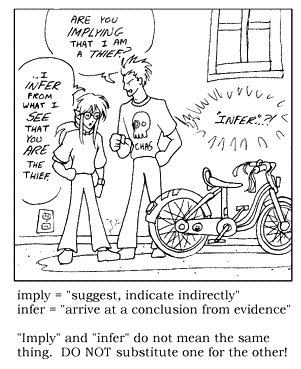 DS: Which of the conventions that you have attended is the best and why?
DS: Which of the conventions that you have attended is the best and why?JLH: I had my strongest sales at the Small Press Expo last year, because everyone actively seeks small press comics there. It's good to hear that attendance at the Small Press Expo increases every year.
I always have a great time at the Motor City Comics Convention, but it's recently evolved into more of a pop-culture show, so not all of the folks who attend that convention are interested in comics.
DS: Is there such a genre as a "woman's comic" and if there is, how would you describe it?
JLH: I don't think a true "woman's comic" exists any more than a true "man's comic" exists. A well-written, well-drawn comic will attract a male audience even if the comic targets female readers, and vice-versa.
DS: In Pocket Editor you point out a few of the common errors people make in their use of the English language. Why don't more people feel strongly about grammar?
JLH: I wish I knew.
DS: What are your future plans?
JLH: Finish the first story arc of Lore, keep creating Pocket Editor minis and see what I can do in the computer animation industry.
DS: What's so great about the comic medium?
JLH: In comics, an individual visual storyteller has complete creative freedom. Other visual storytelling mediums (such as film and animation) usually require a team of skilled people if the project exceeds the length of a short. In contrast, a single person can create a graphic novel (with an unlimited budget for script, acting, special effects, props, costumes and sets). The only limit in the comics medium is a creator's own skills.
Comics cost less to create than films and animations -- another plus for a visual storyteller seeking individual expression. Printed comics require no special equipment (such as projectors, TV sets or computers) for reading.
Other folks have mentioned the above points before, so I'm not saying anything new.
I guess what I like best about comics is the variety of art and stories available for reading.
You can get in contact with Jennifer via
www.celshader.com or jarviaSTOP-@-SPAMcelshader.com
Related Links:
Holy Competition Batman
Interview from 1996
Digital Treats Gallery
Peter Profetto, Charlie Unkless and Jennifer collaborated on a channel ID spot.
LightWave Applied, Version 6.5 & 7.0
The newest book from Joe Tracy (dFX publisher), Dave Jerrard, Jen Hachigian, and the epic software group.
Holy Bears Ladywood High School
Just a Cute Bear.
If you have a comment or question about Small Press then feel free to contact me